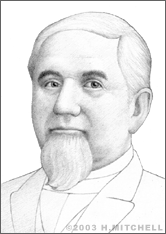George Pullman
George Mortimer Pullman, inventor of the Pullman sleeping car, was born on March 3, 1831 in Brocton, New York. He dropped out of school at age 14, but he had a natural knack for business. He began working with a merchant and then took on an apprenticeship in cabinet-making at age 17.
Pullman’s father had been involved in contracting the moving of large buildings when the Erie Canal was widened. When Pullman moved to Chicago (at age 22), he was able to sell a similar concept there, when the city established a new sewer system. In order for sewage to drain into the river, the new pipes and streets were raised as high as ten feet above ground. Pullman began a business with a couple of partners to construct new foundations for buildings and then move them on top of them. He was quite successful, and made enough money to begin work on an idea he’d been thinking about for years – how to build a comfortable, luxury passenger railroad car.
Pullman first remodeled some old coaches from the Chicago and Alton Railroad into sleeping cars. By 1863 he had finalized a design for what he called the “Pioneer” car, and he forged ahead on a design for what would become known as the Pullman sleeper, finishing it in 1864. These cars were very expensive, at more than five times the price of what a regular railway car cost. The luxurious cars had sleeper compartments with fine sheets and pillows, and were outfitted with accordion connectors between cars to keep out wind and noise.
After President Abraham Lincoln was assassinated, Pullman arranged to have one of his cars transport the President’s body from Washington, D.C. to Springfield, Illinois. This event received a great deal of national attention, and shortly thereafter orders began pouring in. The railroad car business would eventually make him a fortune. His business model was to lease, rather than sell, his sleepers to railways, which would also pay Pullman a portion of the premium they charged passengers to ride in the cars.
To accommodate demand, Pullman built a plant outside Chicago. But there, on the shores of Lake Calumet, Pullman took it one step further, building a town there so his employees could live, shop, eat, and entertain themselves. With over two thousand cars on the rails, his company was worth $62 million in 1893.
Pullman’s master plan backfired, however, when business began to decline in 1894, and workers’ wages, and living conditions, declined. The “Pullman Strike” became an infamous event in U.S. labor history. Many Pullman cars were cut from trains in a show of solidarity with the Pullman workers. Eventually the State of Illinois absorbed the town of Pullman back into the city of Chicago. Nevertheless, Pullman’s designs for sleeping cars and dining cars, which he introduced in 1868, set the standard for comfortable railroad travel.
Pullman died on October 19, 1897. His reputation had been so badly tarnished after the strike incident that his family was worried former employees might try to desecrate his corpse. They buried him in Graceland cemetery, in a deep grave, which they covered with asphalt, concrete and steel rails.


